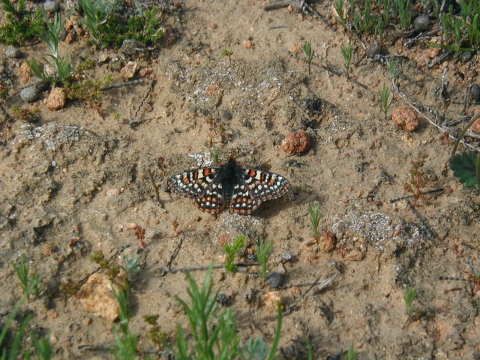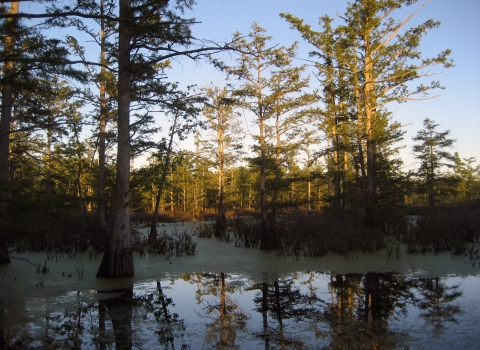| Wingspan: 1.5 in |
| Adult Lifespan: 4 – 8 weeks |
Listing Status
The Quino checkerspot butterfly was listed as endangered on January 16, 1997. This subspecies was added to the endangered species list as a result of significant declines in both species distribution and abundance caused primarily by human actions that degraded, fragmented, and destroyed habitat essential for this subspecies’ survival.
Range
Today, the Quino checkerspot butterfly is only known from western Riverside County, southern San Diego County, and northern Baja California, Mexico. Significant areas of remaining Quino checkerspot butterfly habitat are now protected through inclusion in habitat conservation plan preserve areas.
Habitat
Quino checkerspot butterfly habitat is characterized by patchy shrub or small tree landscapes with openings of several meters between large plants, or a landscape of open swales alternating with dense patches of shrubs; such habitats are often collectively termed “scrublands.” Quino will frequently perch on vegetation or other substrates to mate or bask, and they require open areas to facilitate movement. Optimal habitat appears to contain little or no invasive exotic vegetation. Sustained drought conditions can lead to extirpation of local populations, and broad scale climate anomalies may lead to phenological incompatibility between Quino checkerspot butterfly and their host plants.
Migration
Adult Quino checkerspot butterflies are sedentary by nature and generally fly close to the ground. Many experts familiar with this butterfly believe that populations separated by more than two miles may be demographically isolated. These butterflies may, however, travel greater distanced when influenced by abiotic factors, such as weather. In addition, it appears that Quino checkerspot butterfly populations have evolved to respond to shifting habitat patch suitability. Adult Quino checkerspots are known to congregate on hilltops, ridgelines, and other prominent geographic features; however, whether this behavior (referred to as “hilltopping”) is related to mating has yet to be confirmed.
Host Plants
Adult butterflies will only deposit eggs on species they recognize as host plants. The primary host plants or larval food sources for the Quino checkerspot butterfly are dwarf plantain (Plantago erecta), white snapdragon (Anterrhinum coulterianum), woolly plantain (Plantago patagonica), and Chinese houses (Collinsia concolor). Larval Quino checkerspot butterfly may also use other species of native plantain (Plantago sp.), as well as purple owl’s clover (Castilleja exserta) and thread-leaved bird’s beak (Cordylanthus rigidus), as primary or secondary host plants. The use of purple owl’s clover and thread-leaved bird’s beak however is rare, and these species alone are not believed to support Quino breeding.
Refuge Occurrence
The pattern of occurrence of the Quino checkerspot butterfly on the Otay Sweetwater Unit is small numbers of butterflies in a given location with inconsistent numbers from year to year. This inconsistency may be the result of annual variations in climate, including the amount and timing of rainfall, as well as the range of temperatures in a given year. Historically, this species has been documented in small numbers on at least 13 distinct locations within this unit, including on hilltops and ridges within the Sweetwater River and San Miguel areas, and within the Otay Lakes and Mesa area. In 2009, seven Quino checkerspot butterflies were documented on the Otay-Sweetwater Unit. There are at least eight areas of high-quality habitat (hilltops or ridgelines in open-canopy coastal sage scrub, with primary and secondary larval host plants, abundant and diverse nectar sources, and minimal annual weed invasion) on the Refuge. This species is not known to occur in the Del Mar Mesa Vernal Pool Unit.




